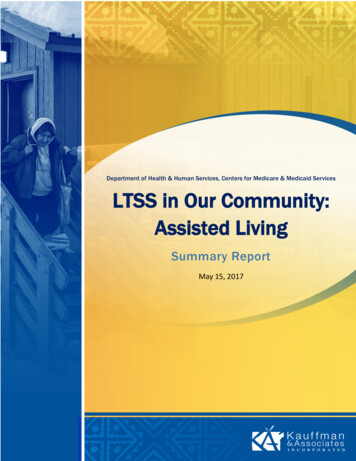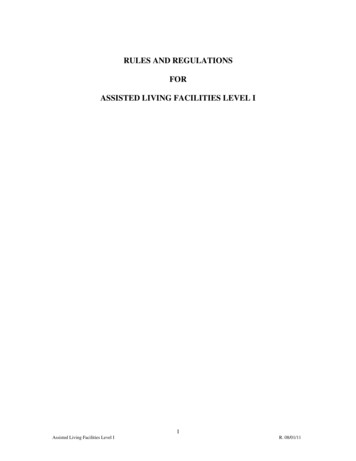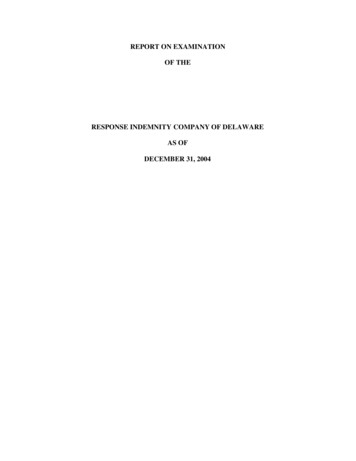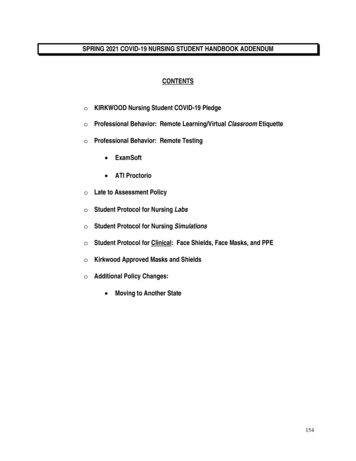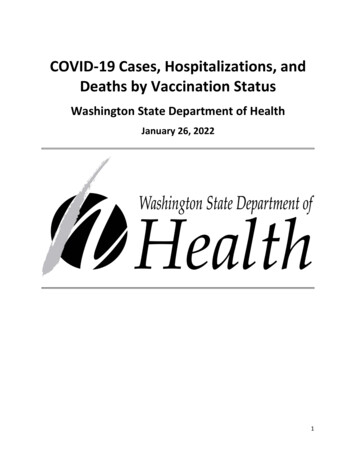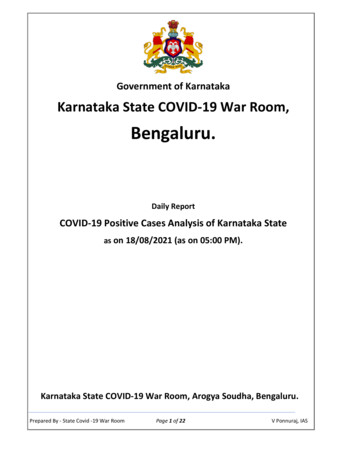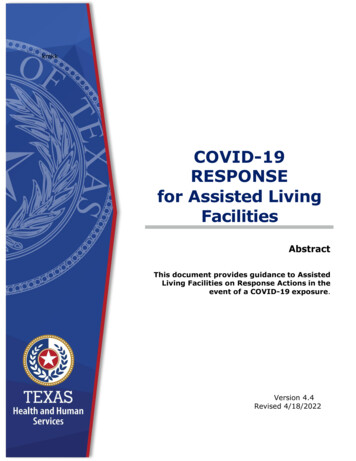
Transcription
kmkkCOVID-19RESPONSEfor Assisted LivingFacilitiesAbstractThis document provides guidance to AssistedLiving Facilities on Response Actions in theevent of a COVID-19 exposure.Version 4.4Revised 4/18/20221
Table of Contents1. Points of Contact for this Document . 42. Table of Changes . 53. Introduction . 9Purpose. 9Goals . 9Overview . 94. Required Screening . 105. Visitors. 12Persons providing critical assistance. 12Personal Visitors . 12Vaccination Status . 136.Infection Control . 14PPE . 14Cleaning and Disinfecting . 14Staff . 15Residents . 15Activities and Dining . 16Memory Care Units and Alzheimer's Certified Units . 167.Vaccines . 18HHSC. 18Find a Vaccine . 188.Outbreaks . 21Outbreak Testing . 21Care for Residents who have COVID-19 . 21Transferring Residents who have COVID-19 . 219. Therapeutics . 2210.Reporting Requirements . 23Confirmed Cases of COVID-19 . 23Test Results . 23Vaccination Data. 24VAERS Adverse Reactions to COVID-19 vaccines . 2411. Resources . 25List of Acronyms . 25Links . 26Attachment 01: Facility Activities Required for ALF COVID-19 Response. 28Attachment 02: Use of PPE in ALFs . 30 deleted Attachment 03: Sample ALF Screening Log . 36Attachment 03: ALF Infection Control Checklist for COVID-19 . 37Attachment 04 26 TAC §553.2001 COVID-19 Emergency Rule . 43Attachment 05 26 TAC §553.2003 Expansion of Reopening Visitation . 48Attachment 06 Long-term Regulation Provider Letter PL 2021-31 . 57Attachment 07 26 TAC §553.2004 ALF COVID-19 Vaccination DataReporting and Communication System Enrollment. 61Attachment 08 Long-term Regulation Provider Letter PL 2020-37 (Revised). 622
Attachment309 Long-Term Care Regulation Provider Letter PL 20-48 . 6310 Long-Term Care Regulation Provider Letter PL 20-50 . 6511 Long-Term Care Regulation Provider Letter PL 20-49 . 6812 Long-Term Care Regulation Provider Letter PL 20-46 . 7113Long-Term Care Regulation Provider Letter PL 2021-01 . 7414 Long-Term Care Regulation Provider Letter PL 2021-04 . 76
1. Points of Contact for this DocumentTexas Health and Human Services CommissionRegulatory Services DivisionMichelle Dionne-Vahalik, DNP, RNAssociate Commissioner, LTCRMichelle.Dionne-Vahalik@hhs.texas.govPhone: 512-962-3260Renee Blanch-Haley, BSN, RNDeputy Associate CommissionerSurvey and Compliance, LTCRRenee.Blanch-Haley@hhs.texas.govPhone: 512-571-2163Jennifer MorrisonManager, ALF, DAHS, HCCSA & PPECCPolicy and RulesJennifer.Morrison@hhs.texas.govPhone: 512-569-87224
2. Table of Changes5DocumentVersionDateVersion 3.05/12/20Reorganized attachment order and included new attachments.Version 3.05/12/20Revised Table of Contents to reflect new order of documentVersion 3.05/12/20Additions made to pages: 2, 3, 5, 6, 7, 8, 9, 15, 16, 17, 18, 19, 21,23, 29, 31, 32, 37, 38, 39, 40, 41, 42, 43, 44, 45, 46, 47, and 48Version 3.16/10/20Revisions made to pages: 7, 8, 18, and 33.Version 3.27/3/20Version 3.37/27/20Complete Re-Org.Version 3.37/27/20Added new HHSC Reporting RequirementsVersion 3.37/27/20New CDC Return to Work Exposure GuidanceVersion 3.37/27/20New Graphics for CDC Symptom Based StrategyVersion 3.3.18/4/20Version 3.48/13/20Revisions made to pages 5, 7, 8, 10, 12, 14, 15 and 16Version 3.48/13/20Added new Section: Re-Opening, pp 20-22Version 3.48/13/20Added Attachment 7 COVID-19 Response Emergency Rule 26 TAC§553.2001, pp 51-55Version 3.48/13/20Added Attachment 8 Phase 1 Limited Visitation Rule 26 TAC§553.2003, pp 55-59Version 3.48/13/20Added Attachment 9 LTCR Provider Letter PL 20-24 pp 60-64Version 3.510/2/20Updated email addresses to texas.gov for document POCVersion 3.510/2/20Revisions made to pages 7, 9-17, 19-24, 27-31, 37 and 57.Version 3.510/2/20Deleted Attachment 8 Phase 1 Open Attachment 8 Phase 1 LimitedVisitation Rule 26 TAC §553.2003Version 3.510/2/20Added Attachment 8 Expansion of Opening Visitation Rule 26 TAC§553.2003Version 3.510/2/20Deleted Attachment 9 LTCR Provider Letter PL 20-24Version 3.510/2/20Added Attachment 9 LTCR Provider Letter PL 20-38Version 3.510/20/20Added Attachment 8 Expansion of Opening Visitation Rule 26 TAC§553.2003Version 3.510/20/20Added Attachment 9 LTCR Provider Letter PL 20-42Version 3.510/20/20Revisions made to pages 10-17 and 24-27.ChangeRevisions made to pages: 10, 11, 12, 16, 17, 18, 19, 20, 21, 22,23, 24, 25, 26, 27, 29, 30, 34, 37, 38, 42, 45 and 52.Corrected Jennifer Morrison's contact phone number on page 2.
6DocumentVersionDateVersion 3.5.111/5/20Revisions made to pages: 4, 12, 18 and 23.Version 3.612/9/20Added Attachment 10 LTCR Provider Letter PL 20-48Version 3.612/9/20Added Attachment 11 LTCR Provider Letter PL 20-50Version 3.612/9/20Added Attachment 12 LTCR Provider Letter PL 20-53Version 3.612/9/20Added Attachment 13 LTCR Provider Letter PL 20-49Version 3.612/9/20Added Attachment 14 LTCR Provider Letter PL 20-46Version 3.612/9/20Added Attachment 15 LTCR Provider Letter PL-37 (revised)Reporting Guidance for Long-term Care ProvidersVersion 3.71/22/21Added Attachment 9 26 TAC §553.2004 ALF COVID-19 VaccinationData Reporting RuleVersion 3.71/22/21Added Attachment 17 LTCR Provider Letter PL 2021-01 VaccinationData Reporting RevisedVersion 3.71/22/21Added new Section for COVID-19 VaccinesVersion 3.71/22/21Added survey monkey link to report Vaccines Administered in ALFsVersion 3.71/22/21Revisions made to pages 9-12, 20-22, 25-27, 30-35, 58 and 59.Version 3.71/25/21Added ALF Outbreak Data ChartVersion 3.83/24/21Added Infection Control Zones Guidance on page 18Version 3.83/24/21Deleted (5) regarding foreign travel (obsolete) on p 66Version 3.83/24/21Revision to 4. Required Screening on page 9Version 3.83/24/21Revision to 5. VisitorsVersion 3.83/24/21Revision to Attachment 8Version 3.83/24/21Revision to Attachment 11Version 3.98/6/21Revisions to 4. Required ScreeningVersion 3.98/6/21Revisions to 5. Visitors including new mask guidanceVersion 3.98/6/21Revisions to 6. Infection ControlVersion 3.98/6/21Revisions to 7. VaccinesVersion 3.98/6/21Revisions to 8. OutbreaksVersion 3.98/6/21Added Revised §553.2001 COVID-19 Emergency RuleVersion 3.98/6/21Added Revised §553.2004 COVID-19 Emergency Rule VaccinationData ReportingVersion 3.98/6/21Deleted PL 20-53 (obsolete guidance for dining, activities andvolunteers)Version 3.98/6/21Deleted Obsolete Version of Emergency Rule §553.2001Version 3.98/6/21Deleted Obsolete Version of Emergency Rule §553.2004Version 3.98/6/21Deleted ALF Outbreak Data (obsolete)Change
7Version 4.08/27/21Deleted Attachment 7 Obsolete Emergency Visitation Rule§553.2003 to replace with revised ruleVersion 4.08/27/21Added Attachment 7 Revised 8/21 §553.2003 Emergency VisitationRuleVersion 4.08/27/21Deleted Attachment 8 Obsolete LTCR Provider Letter PL 2021-12Version 4.08/27/21Deleted Obsolete LTCR FORM 2196: Expansion of ReopeningVersion 4.08/27/21Added Attachment 8 LTCR Provider Letter PL 2021-31 (Replaces PL2021-12)Version 4.08/27/21Revisions to 4. Required ScreeningVersion 4.08/27/21Revisions to 5. VisitorsVersion 4.08/27/21Revisions to 6. Infection ControlVersion 4.08/27/21Revisions to 7. VaccinesVersion 4.08/27/21Revisions to 8. OutbreaksVersion 4.08/27/21Revisions to 9. ReportingVersion 4.08/27/21Deleted HHSC LTCR Activities with ALFs that have COVID-19 Casesthe activities are no longer doneVersion 4.08/27/21Deleted State/Regional/Local Support-these resources are no longeravailableVersion 4.110/27/21Updated 4 Required Screening for fully vaccinated staff andresidentsVersion 4.110/27/21Updated 5 Visitors to comply with Governor Abbott's new GA 40Version 4.110/27/21Updated 6 Infection Control for fully vaccinated staff and residentsand deleted obsolete and redundant informationVersion 4.110/27/21Updated 7 Vaccines with information on additional and boosterdosesVersion 4.110/27/21Updated 8 Outbreaks to delete redundant and obsolete informationVersion 4.110/27/21Added 9 TherapeuticsVersion 4.110/27/21Updated 10 Reporting Requirements with information on additionaland booster dosesVersion 4.110/27/21Deleted 11 End of Isolation/Staff Return to work, redundantinformationVersion 4.110/27/21Updated Resources to delete you tube links that are obsolete andsome no longer workingVersion 4.211/16/21Added Activities and Entertainers section under 6. Infection Control.Version 4.31/25/22aDeleted some screening criteria for individuals entering an ALF dueto changes in CDC guidance.Version 4.31/25/21Deleted Attachment 3, the chart for staff return to work/end ofisolation flow chart due to changes in CDC guidance.Version 4.31/25/21Deleted some information about vaccines due to changes in CDCguidance.Version 4.31/25/21Added clarifying details to guidance for reporting positive COVIDVisitation Status Attestation Form for ALF
cases.8Version 4.44/14/22Added exposure back to screening criteria for individuals entering anALF due again to changes in CDC guidance.Version 4.44/14/22Added Updated 2/16/22 Attachment 06 26 TAC §553.2003Expansion of Reopening VisitationVersion 4.44/14/22Updated information in Visitors section to current 26 TAC §553.2003Version 4.44/14/22Updated information in Residents to reflect current CDC guidanceVersion 4.44/14/22Updated vaccination information to reflect new CDC terminologyVersion 4.44/14/22Clarified definition for outbreak according to current 26 TAC§553.2003Version 4.44/14/22Revised due to updated ALF mitigation rules in 553.2001Version 4.44/14/22Deleted example of screening log and renumbered attachments
3. IntroductionPurposeThis document provides assisted living facilities (ALFs) with response guidance inthe event of a positive COVID-19 case associated with the facility. A facility mustdevelop a written COVID-19 Response Plan in accordance with 26 TAC §553.2001.Goals Rapid identification of COVID-19 situation in an ALFPrevention of spread within the facilityProtection of residents, staff, and visitorsProvision of care for an infected resident(s)Recovery from an in-house COVID-19 eventOverviewResidents of long-term care (LTC) facilities are more susceptible to COVID-19infection and the detrimental impact of the virus than the general population. Inaddition to the susceptibility of residents, a LTC environment presents challenges toinfection control and the ability to contain an outbreak with potentially rapid spreadamong a highly vulnerable population.This document provides LTC facilities’ immediate actions to consider and actions forextended periods after a facility is made aware of potential infection of a resident,provider, or visitor.9
4. Required ScreeningAn ALF must screen all individuals who enter the facility prior to entry in accordancewith the rules at 26 TAC §§553.2001 (except for emergency services personnel inan emergency), added in accordance with the following screening criteria asrecommended by HHSC: positive viral test for COVID-19symptoms of COVID-19or close contact with someone with COVID-19 infection added deleted symptoms of COVID-19 per the CDC. Currently they are:o fever, defined as a temperature of 100.4 Fahrenheit and above;o signs and symptoms of COVID-19, including chills, cough, shortness ofbreath or difficulty breathing; fatigue, muscle or body aches, headache,new loss of taste or smell, sore throat, congestion or runny nose, nauseaor vomiting, diarrhea; ando any other signs and symptoms as outlined by the CDC in Symptoms ofCoronavirus at cdc.gov; orhas tested positive for COVID-19 in the last 10 days oris ill with a respiratory illness, regardless of whether the person is fullyvaccinated, with these exceptions:o the individual is seeking entry to provide essential services such asdoctors, nurses, home health and hospice staffo the individual is staff who is either fully vaccinated or has recoveredfrom COVID-19 within the last 3 monthso the individual is a resident who is either fully vaccinated or hasrecovered from COVID-19 within the last 3 months. deleted If a visitor meets any of the screening criteria, they must leave the facility andreschedule the visit.If staff meets any of the screening criteria, they cannot report to work until theymeet CDC return to work criteria.If a resident meets any of the screening criteria. implement increased infectioncontrol measures including quarantine as applicable and monitor for symptoms ofCOVID-19 according to guidance.Post signage at all entrances of the facility reminding individuals not to enter thefacility prior to being screened. deleted Document in writing all persons who enter the building in alog kept at the entrance to the facility. Include, at least, the date, theperson's name, current contact information, and the data from thescreening (presence/absence of fever and symptoms). The screeninglog might contain protected health information and must be protectedin accordance with applicable state and federal law. deleted 10
Do not restrict surveyors. HHSC is constantly evaluating their surveyors to ensurethey don’t pose a transmission risk when entering a facility. For example, surveyorsmight have been in a facility with COVID-19 cases in the previous 10 days, butbecause they were wearing PPE effectively per the CDC guidelines, they pose a lowrisk to transmission in the next facility and must be allowed to enter. However,there are circumstances under which surveyors should not enter, such as if theyhave a fever or any additional signs or symptoms of illness.11
5. Visitors26 TAC §553.2003 Expansion of Reopening Visitation rule added updated2/16/22 added .Persons providing critical assistancemust be allowed to enter the facility provided they pass required screening.These include: Family members and loved ones of residents at the end-of-life; Essential caregivers; Emergency responders (do not screen in an emergency); Persons with legal authority to enter, including:o Government personnel performing their official duties, including HHSCsurveyors whose presence is necessary to ensure the ALF is protectingthe health safety of residents and providing appropriate care;o Law enforcement officers (do not screen in an emergency) ando Representatives of the Long-term Care Ombudsman's Office andrepresentatives of Disability Rights Texas; and Providers of essential services which include contract doctors, contractnurses, home health and hospice workers, health care professionals, contractprofessionals, clergy members and spiritual counselors, whose services arenecessary to ensure resident health and safety.This list is not exhaustive. A facility must use its best judgment to determine whichpersons are "essential" to protect the health and safety of a resident.Personal VisitorsALFs must allow all residents deleted who are COVID-19 negative to havepersonal visitors added regardless of the resident's COVID status added .Visits can occur where adequate space is available as necessary to ensure physicaldistancing between other residents and visitors, including the resident's room. Thefacility must ensure a comfortable and safe outdoor visitation area, consideringoutside air temperature and ventilation.Visitors and residents are no longer required, by HHSC rule, to wear masks or facecoverings or PPE.Visits are not required to be scheduled in advance. An ALF can have scheduledvisits and unscheduled visits. ALFs can schedule personal visits in advance orpermit personal visits that are not scheduled in advance, or both. Scheduling inadvance must not be so restrictive as to prohibit or limit visitation for residents.See Expansion of Reopening Visitation at 26 TAC §553.2003 for all requirements.12
All ALFs must: offer a complete series of a one- or two-dose COVID-19 vaccine to residentsand staff and document each resident’s choice to vaccinate or not vaccinate(“Offer” in this context means to administer, arrange/assist, OR educate/giveinformation about the COVID-19 vaccine); deleted redundant ANDdocument the resident’s choice to vaccinate or not vaccinate deleted allow visitors of any age; develop and enforce written policies and procedures related to visitation,including whether visitors and residents must wear a face mask, facecovering, or appropriate PPE during visits; inform residents and visitors of the facility’s infection control policies andprocedures related to visitation; limit the movement of visitors through the facility to minimize interactionwith other persons; and give all residents equal access to personal visitors, end-of-life visitors andessential caregivers. deleted provide hand-washing stations or hand sanitizer to visitors andresidents before and after visits; and facilitate visits in a way that allows cleaning and cleaning and sanitizingcommon visitation areas.Salon Services VisitorsAn ALF can allow a salon services visitor (barber, beautician, or cosmetologistproviding hair care or personal grooming services to a resident) to enter the facilityto provide hair care or personal grooming services to COVID-19 negative residents.The rules in §553.2003 detail the requirements for salon visits. deleted Vaccination StatusAn ALF can ask about a visitor’s COVID-19 vaccination status but must not requireany visitor to provide documentation of their COVID-19 vaccination status as acondition of visitation or to enter the facility. A personal visitor may refuse toprovide information about their vaccination status. deleted redundant HHSC as a state agency cannot require vaccinations. A facilityis a private business and should consult with their Legal and Human Resources areato address state and federal mandates regarding vaccines. deleted deleted Visual Aid:Table of visitors allowed according to resident COVID-19 statusEssential Caregivers (EC)ALFs are required to allow for all residentswith any COVID-19 statusPersonal Visitors (not EC)End-of-Life Visitors13ALFs are required to allow for residentswith COVID-negative statusALFs are required to allow for all residentswith any COVID-19 status
Providers of CriticalAssistanceSalon Service VisitorsALFs are required to allow for all residentswith any COVID-19 statusALFs can allow for residents with COVIDnegative status deleted 6.Infection ControlSee Attachment 1: ALF COVID-19 Response Infographics &Flowcharts, for visual aids outlining ALF response activities. Complywith all CDC guidance related to infection control.Establish infection control zones to keep resident cohort groupsseparate from each other and to limit movement of staff betweenthe separate zones. Cold Zones for COVID-19 negative residents Warm Zones for monitoring residents with unknown COVID-19 status Hot Zones for COVID-19 positive residentsAn ALF must have spaces for staff to doff and dispose of PPE used in a warmzone or hot zone, and wash hands or use hand sanitizer before entering acold zone in the facility:PPE deleted Maintain a two-week supply of PPE in accordance with 26 TAC§553.2001(c)(4). deleted Make necessary PPE available in areas where care is provided to residents withCOVID-19 and residents with unknown COVID-19 status. Put a trash can near theexit inside the resident room to make it easy for staff to discard PPE prior to exitingthe roomCleaning and DisinfectingIncrease environmental cleaning. Clean and disinfect all frequently touched surfacessuch as doorknobs/handles, elevator buttons, bathroom surfaces/fixtures, remotecontrols, and wheelchairs.Make sure EPA-registered hospital-grade disinfectants are available. Refer to List Non the EPA website for EPA-registered disinfectants that have qualified under EPA’semerging viral pathogens program for use against COVID-19.Provide supplies for recommended hand hygiene. Have alcohol-based hand sanitizerwith 60–95 percent alcohol easily accessible. Make sure sinks are well-stocked withsoap and paper towels for handwashing.Review your infection control policies and procedures. Review your emergencypreparedness and response plan required by 26 TAC §553.275. Update as needed.Ensure that any emergency plans specific to hurricanes or other natural disasters14
account for COVID-19.StaffStaff must always wear proper PPE when caring for residents with COVID-19 orunknown COVID-19 status per 26 TAC §553.261(f).Assisted living facilities should minimize the movement of staff between facilitieswherever possible.To encourage staff who are ill to stay home ALFs should enforce sick leave policiesthat do not penalize them with loss of status, wages, or benefits.Require staff with symptoms of COVID-19 to report sick by phone or other virtualmethod consistent with facility policy. Staff must not enter the facility until theymeet current CDC return to work criteriaIf a staff member has a confirmed case of COVID-19 they must not enter thefacility until they meet the current CDC return to work criteria.Per CDC guidance, staff who have had a higher risk exposure may not need to berestricted from work. Review CDC HCP Guidance-Risk Assessment and CDCStrategies to Mitigate Healthcare Personnel Staffing Shortages recommendationsfor Healthcare Personnel During the COVID-29 Pandemic for possible exceptionsand additional information.Note: If a staff member was diagnosed with a different illness (e.g., influenza) andwas never tested for COVID-19, base their return to work on the criteria associatedwith that diagnosis.ResidentsAsk residents to report if they feel feverish or have symptoms of respiratoryinfection and coronavirus. delete Actively monitor all residents upon admissionand at least daily for fever and symptoms of COVID-19 in accordance with HHSCguidance. deleted If a resident has fever or symptoms, implement increasedinfection control measures including added daily monitoring of symptoms and added quarantine as applicable.Leaving and returningResidents have the right to leave and return to the facility for any reason, and thefacility cannot restrict residents from exercising this right. The facility has aresponsibility to inform residents of the increased risk of contracting COVID-19 andthe importance of safety precautions like avoiding crowds, washing hands often andmaintaining physical distancing from others whenever possible, so that the residentis making an informed decision.Same dayFor a resident who leaves the ALF and returns the same day, the deleted is notnecessarily considered to have unknown COVID-19 status. The deleted resident's15
COVID-19 status is the same as it was when they left.OvernightPer CDC guidance, a resident who is either up to date with all recommendedCOVID-19 vaccines, including any booster dose(s) when eligible, fully vaccinated orhad COVID-19 in the previous three months and has fully recovered, does not haveto quarantine, even if added they were away from the facility overnight or added if they had close contact with someone who has COVID-19.All other residents who are new admissions, readmissions, or spent one or morenights away from the ALF, deleted are considered to have unknown COVID-19status. Residents with unknown COVID-19 status deleted must be quarantinedper the CDC guidance on when to quarantine. If no symptoms develop during dailymonitoring, quarantine can end after day 10 without testing; or after day 7 with anegative COVID-19 test result (test must occur on day 5 or later). Continue tomonitor the resident for a total of 14 days after potential exposureFully vaccinated people who do not quarantine should still watch for symptoms ofCOVID-19 for 14 days following an exposure. If they experience symptoms, theyshould be clinically evaluated for COVID-19, including testing for COVID-19, ifindicated. Keep in mind that quarantine does not mean the resident must remainin their room for the duration of the quarantine period. deleted Dailymonitoring is a must, as well as following infection control protocols. deleted .Activities and DiningEntertainers, families and volunteer groupscan enter the facility if they and the ALF adhere to the following: The ALF must screen each person entering the facility prior to entry, inaccordance with the ALF COVID-19 emergency rule at 26 TAC §553.2001.Only persons who pass the screening can enter the facility. deleted The ALF must document visitors in a log at the entrance of thefacility, in accordance with the ALF visitation emergency rules at 26 TAC§553.2003. deleted All individuals who enter the facility for the purposes of activities or dining arebound by the rules for personal visitors at 26 TAC §§553.2001 and 553.2003.Some examples of visitors joining in activities and dining: A small group, such as members from a local club or a group of high schoolstudents who volunteer to participate in an activity with residents, such asputting up decorations or putting on a performance.Family joining a resident for a meal at an individual family table that isadequately distanced from other residents' family tables.ALF staff taking residents in community busses to an event or an outing.Memory Care Units and Alzheimer's Certified UnitsInfection prevention strategies to prevent the spread of COVID-19are especially challenging to implement in dedicated memory careunits and Alzheimer's certified units where numerous residents with16
cognitive impairment reside together. These residents can have adifficult time following recommended infection prevention practices.Changes to resident routines, disruptions in daily schedules, use of unfamiliarequipment, or working with unfamiliar caregivers can lead to fear and anxiety,resulting in increased depression and behavioral changes such as agitation,aggression, or wandering.Follow recommended guidance below from the CDC for considerations regardingresidents with dementia, in memory care or Alzheimer's certified units.Considerations for Memory Care Units in Long-term Care Facilities17
7.VaccinesEveryone added five added deleted 12 deleted years old and older is eligible for afree COVID-19 vaccine in Texas.HHSCHHSC as a state agency cannot require vaccinations. A facility is a private business andshould consult with their Legal and Human Resources area to address state and federalmandates regarding vaccines.Find a VaccineThere are many ways to get fully vaccinated in Texas. For the most current vaccinationresources visit DSHS COVID-19 Vaccine InformationMobile Vaccine ProgramThe state mobile program provides a way for ALFs to schedule free mobile vaccinations. ALFswith five or more individuals who voluntarily choose to be vaccinated can call 844-90-TEXAS(844-908-3927) and select Option 3 to schedule a visit.Local PharmaciesCheck your local pharmacy’s website to see if vaccine appointments are available. You canalso check CDC’s Federal Retail Pharmacy Program website.Texas Public Health Vaccine SchedulerThe Texas Vaccine Scheduler helps Texans get scheduled for a COVID-19 vaccine at clinicshosted by participating Texas public health entities.Register online at GetTheVaccine.dshs.texas.gov You will be notified by email or text whenand where to get the vaccine. If there’s not an available clinic near you, you will be directedto other places to get your vaccine.Call (833) 832-7067 if you don’t have internet or need help signing up. Call center support isavailable Monday–Friday from 8am – 6pm and Saturday from 8am–5pm. Spanish languageand other translators are available to help callers.Find Vaccine by PhoneAmericans ca
This document provides assisted living facilities (ALFs) with response guidance in the event of a positive COVID-19 case associated with the facility. A facility must develop a written COVID-19 Response Plan in accordance with 26 TAC §553.2001. G





